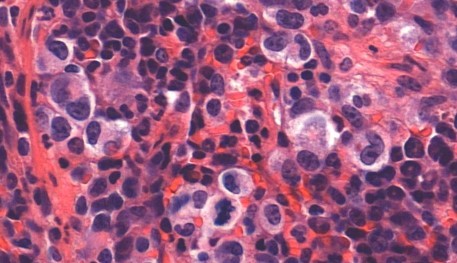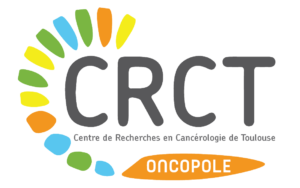
Fabienne Meggetto & Laurence LAMANT
Regulation of microarn and circular arn and their theranostic potential in alk tyrosine kinase-associated anaplastic t-cell lymphoma
Anaplastic large cell lymphoma (ALCL) is a lymph node T-cell lymphoma, often associated with cutaneous localizations, which mainly affects children and young adults. Although good responders to chemotherapy, approximately 30% of patients develop very aggressive relapses (Lamant et al, JCO, 2011).

In approximately 80% of cases, ALCL is associated with a chromosomal translocation involving the ALK gene. The most common chromosomal translocation leads to the expression of the NPM-ALK fusion protein. Our work on the oncogenic role of this fused tyrosine kinase has allowed:
- to show that although emerging from mature T cells, ALK(+) ALCLs share characteristics with thymic precursors (Congras et al, JCI 2020);
- to develop the first ALCL ALK(+) conditional transgenic mouse models (Giuriato et al, Blood, 2010) ;
- to implicate, through these mouse models, microRNAs and skin inflammation in ALK(+) tumorigenesis and aggressiveness (Dejean et al, Blood, 2012 et Leukemia, 2011 ; Desjobet el al, Blood, 2011) ;
- to show, for the first time, the impact of microRNAs whose expression is regulated by DNA methylation in resistance to conventional chemotherapy and targeted anti-ALK therapy (Hoareau-Aveilla et al , JCI, 2015 et Haematologica, 2018 ; Congras et al Oncotarget, 2018).
Based on our results and focusing our research projects on microRNAs and their regulation, our goals are to identify biomarkers associated with ALCL ALK(+) therapeutic response to help i) stratify patients, ii) tailor treatment and iii) identify new therapeutic leads.
To this end, using annotated patient cohorts, novel cell models (PDX, human cell lines, ALK(+) transduced human CD4) including several established in the laboratory, we generate genome-wide and single-cell RNAseq data (coding and non-coding RNAs) to extract and characterize at the molecular level novel micro RNAs (miRNAs) and circular RNAs (circRNAs) regulatory pathways. Using bioinformatics tools, we also explore the tumor microenvironment in the context of response or non-response to conventional chemotherapy, anti-ALK-targeted therapy or immunotherapy.

Publications
– Congras A, Hoareau-Aveilla C, Caillet N, Tosolini M, Villarese P, Cieslak A, Rodriguez L, Asnafi V, Macintyre E, Egger G, Brousset P, Lamant L, Meggetto F. ALK-transformed mature T lymphocytes restore early thymus progenitor features. Journal of Clinical Investigation. 2020, 1;130(12):6395-6408.
– Hoareau-Aveilla C, Quelen C, Congras A, Caillet N, Labourdette D, Dozier C, Brousset P, Lamant L, Meggetto F. MiR-497 suppresses cycle progression through an axis involving CDK6 in ALK-positive cells. 2018, Haematologica. 104(2):347-359.
– Congras A, Caillet N, Torossian N, Quelen C, Brousset P, Lamant L, Meggetto F*, Hoareau-Aveilla C. Doxorubicin-induced loss of DNA topoisomerase II and DNMT1-dependent suppression of MiR-125b induces chemoresistance in ALK-positive cells. 2018, Oncotarget. 8;9(18):14539-51.A. *corresponding auteur
– C. Hoareau-Aveilla ; T. Valentin; C. Daugrois ; C. Quelen; G. Mitou; S. Quentin; J. Jia; S. Spicuglia; P. Ferrier; S. Giuriato; P. Brousset ; L. Lamant; F. Meggetto. Reversal of microRNA-150 silencing disadvantages the growth of the Crizotinib-resistant NPM-ALK-positive cells. 2015, Journal of Clinical Investigation, 1;125(9):3505-18.
– Dejean E., Foisseau M., Lagarrigue F., Lamant L., Prade N., Marfak A., Delsol G., Giuriato S. Gaits-Iacovoni F., Meggetto F. ALK+ALCL induce cutaneous HMGB-1-dependent interleukin-8/CXCL8 production by keratinocytes through NF-kB activation. 2012, Blood, 17;119(20):4698-707
– Dejean E., M.H. Renalier, M. Foisseau, X. Agirre, GR. de Paiva, T. Al Saati, J. Soulier, C. Desjobert, L. Lamant, F. Prósper, DW. Felsher, J. Cavaillé, H. Prats, S. Giuriato, F. Meggetto. MicroRNA-16 down-regulation induces VEGF expression in anaplastic lymphoma kinase (ALK) positive anaplastic large-cell lymphoma. 2011, Leukemia, 25(12):1882-1890.
– Desjobert C., MH. Renalier, J. Bergalet, N. Joseph, A. Kruzincsky, J. Soulier, E. Dejean, E. Espinos, F. Meggetto, J. Cavaillé, G. Delsol, L. Lamant. MiR-29a downregulation in ALK-positive Anaplastic Large Cell Lymphomas participates to apoptosis blockade through Mcl-1 overexpression. 2011, Blood, 117(24):6627-6637.
– Lamant L, McCarthy K, d’AmoreE, Klapper W, Nakagawa A, Fraga M, Maldyk J, Simonitsch-Klupp I, Oschlies I, Delsol G, Mauguen A, Brugières L, Le Deley MC. Prognostic impact of morphologic and phenotypic features of childhood ALK-positive anaplastic large-cell lymphoma: results of the ALCL99 study. 2011, Journal of Clinical Oncology, 10;29(35):4669-76.
Journals
– Loelia Babin, Elissa Andraos, Steffen Fuchs, Stéphane Pyronnet, Erika Brunet, and Fabienne Meggetto. From circRNAs to fusion circRNAs in hematological malignancies. Journal of Clinical Investigation, 2021, 10.1172/jci.insight.151513
– Andraos E, Dignac J, Meggetto F. NPM-ALK: A Driver of Lymphoma Pathogenesis and a Therapeutic Target. Cancers. 2020;13(1):144.
– Fuchs S, Naderi J, Meggetto F. Non-Coding RNA Networks in ALK-Positive Anaplastic-Large Cell Lymphoma. International Journal of Molecular Sciences. 2019, 30;20(9).
– Hoareau-Aveilla C, Meggetto F. Crosstalk between microRNA and DNA Methylation offers Potential Biomarkers and Targeted Therapies in ALK-Positive Lymphomas. 2017, Cancers. 3;9(8). pii: E100. doi: 10.3390/cancers9080100.
– Hoareau-Aveilla C, Merkel O, Meggetto F. MicroRNA and ALK-positive anaplastic large cell lymphoma. Frontiers Bioscience, 2015; 7:217-25.
Funding in the last 5 years:
– Laboratoire d’excellence Toulouse Cancer (Labex TOUCAN) depuis 2015
– Programme de Recherche Translationnelle en Cancérologie INCa-DGOS 2023-2025
– Fondation ARC
– Fondation de France
– Fédération Grandir Sans Cancer
– Association Eva Pour La Vie
– Association Cassandra
– Lion’s Club de Lourdes
– Fonds Amgen france pour la science et l’humain
– Fondation Fonroga

